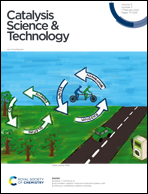The intricacies of the “steady-state” regime in methanol-to-hydrocarbon experimentation over H-ZSM-5†
Abstract
The various reaction regimes in methanol to hydrocarbon conversion, i.e. initiation, transition, steady-state and deactivation, have been experimentally assessed over a H-ZSM-5 zeolite with considerable acidity (Si/Al = 40). Aiming at directly observing all different reaction regimes, the operating conditions were varied in a wide temperature and space time range from 325 to 450 °C and from 1 to 15 kg s mol−1, respectively. It resulted in oxygenate (i.e. methanol + dimethyl ether) conversions between 3 to 95%, without interference of transport phenomena. At low oxygenate conversion (<10%) and low temperature (325 °C), a dynamic behaviour was observed and ascribed to the transition regime. When increasing the conversion, by increasing the temperature moderately (325–400 °C), the reaction could be brought to a “steady-state” regime, defined by stable conversion and product selectivities for at least 8 hours. A further temperature increase (>400 °C) induced a fast formation of deactivating species, inevitably resulting in the loss of catalytic activity. Notably, during the flushing protocol, which was employed in between reaction periods to preserve catalytic activity, temperature strongly affected the amount of retained material, interpreted in terms of the rate of decomposition and diffusion of heavy hydrocarbons out of the zeolite. By controlling this protocol, well-defined intrinsic kinetic “steady-state” data could be acquired.



 Please wait while we load your content...
Please wait while we load your content...